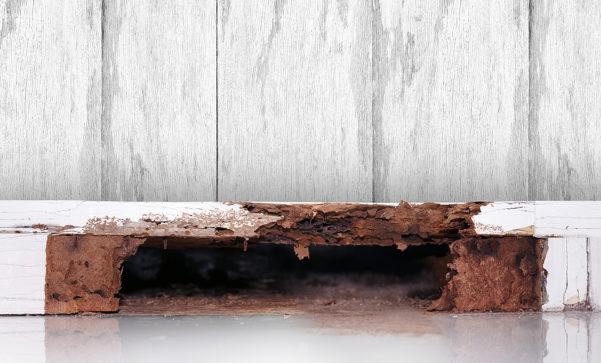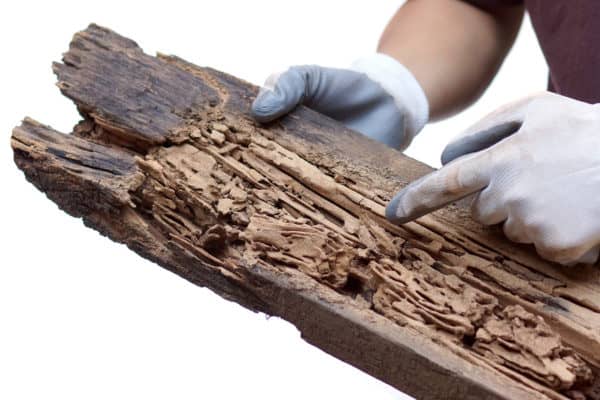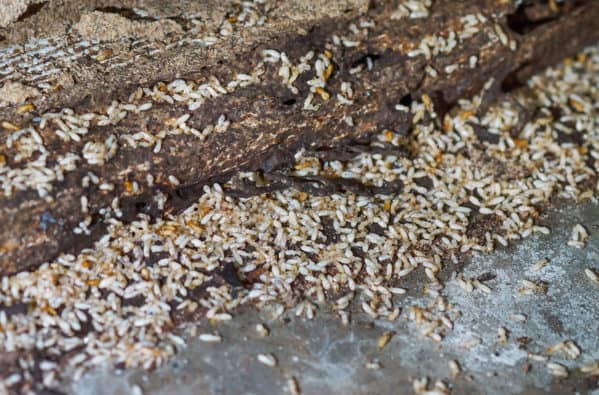READY TO GET STARTED?
REQUEST A FREE ESTIMATE
Fill out the form below or call (888) 466-7849 for a free, no-obligation estimate.

Termites are known to cause significant and expensive home and property damage each year. These pests can easily go undetected for a long period of time and, in return, cause substantial damage to your property. Dealing with termites can be a huge undertaking and while you should always reach out to a professional if you have been infested with them, you can take steps to help prevent an invasion.
Keep Dry!
Subterranean termites need an abundant amount of water to survive. These pests will seek out moist and wet areas in or around your home for a new colony site. It’s extremely important to check for any leaky faucets, pipes, and appliances inside your home. Additionally, storm drains should be directed away from your house and draining at least a few feet from your home’s foundation. Making sure there is no available moisture is an easy way to prevent a termite infestation and subsequent damage.
Beware the Mulch!
Mulch can be a great tool to landscape your yard, but not many know that it can attract termites right into your home! Mulch, which is comprised of wood chips, can retain moisture, making it a perfect food source for termites. If you do decide to use mulch, try to keep at least a 4-inch barrier between the mulch and the side of your home. Along with mulch, try to keep shrubbery, lumber, and wood away from the foundation of the house.
Inspect It!
Inspecting your own home is probably the easiest way to prevent termites. Since termites like to consume wood, check for wood damage throughout your home. When wood is damaged it will make a hollow or papery sound when tapped on. Periodically check the exterior of the home. Maintaining your home’s wood siding and window frames help prevent termites from sneaking in. Some signs you have termites are blistering sheetrock, mud tunnels, cracks in the foundation, and discarded termite wings.
If you’ve determined that termites have infested your home, it’s best to call a professional. A local pest control company can provide you with an inspection and the best plan of action for termite control.

Termites cause billions of dollars in damage each year. There are two main types of termites: drywood termites and subterranean termites. Drywood termites are found in warm, southern climates. They establish their colonies deep within the wood that they eat. As they consume wood, they create mazes of tunnels and chambers within the walls and foundation of your home. Subterranean termites are found throughout the continental United States. These termites build their colonies underground and emerge in search of food. They can enter your home through cracked or unsealed foundations.
Because termites eat wood from the inside out, termite damage often goes undetected for long periods of time. Often in fact, by the time signs of termites appear, colonies are well established and significant damage has already been done. Because of this, it is recommended that you get a termite inspection at least once per year or any time you find signs of termite activity. The average termite inspection cost is usually free (if no termite report is required, as in the case of a real estate transaction), or can be anywhere from $45 to over $100 depending on the size of your home and the exterminating company hired. A licensed termite inspector will perform a visible inspection on the readily accessible areas of your home looking for evidence of termites. The inspection should include a visual inspection of the entire interior of the home (including crawlspace and basement) and the exterior of the property. If evidence of termites are found, a termite exterminator will be required to provide appropriate termite control options and treatment.
Spotting signs of termites is a good indicator that a well established colony is nearby. But what are these signs? What should you look for? Here are 6 common signs of termites:
If you suspect you have a termite problem or if you spot signs of a termite infestation, contact a professional termite control company who can provide you with a thorough termite inspection and a comprehensive termite protection and treatment plan.
Summer Wildlife Removal: Common Home Invaders
What Are These Little Black Ants?

Termites cause billions of dollars in damage each year. Because they work from the inside out, infestations are often not found until significant damage has already been done. Spring marks the beginning of the termite swarming season and these destructive pests are found in most of the United States (except for Alaska). What do you need to know before swarming season starts to help control termites? Find out the answers to many of your termite questions below.
Termites swarm as the weather begins to warm, usually at the beginning of spring or summer and usually after a rain event. Termites swarm when they go in search of a location to establish a new colony. Colonies typically don’t produce a swarm until they have been established for at least 3 years.
If a swarm happens inside your home, most of them will not survive to establish a new colony but it does mean that your home is likely infested. If a swarm happens outside your home or if you notice just a few stragglers inside, your home is most likely not infested but a colony (or multiple colonies) are present nearby.
Swarming termites have one purpose – to reproduce and establish a new colony. In fact, they don’t have biting or chewing mouthparts to cause damage to your home. Several hundred swarmers are produced by each colony but only a small percentage of these actually survive to start the new colony.
Termites have straight antennae and wide bodies without pinched waists. They are usually black or dark brown in color. Swarming termites have wings that are the same length and clear in color. Termites are found in decaying stumps, trees, wood debris, lumber, and other wooden structures. They cause structural damage by eating wood and other cellulose-based products like paper.
Flying ants (also known as carpenter ants) have elbowed antennae and pinched waists. They can be black, brown or reddish in color. They have 2 pairs of wings that differ in size and are tinted brown in color. Carpenter ants also inhabit wood and wood structures; however, they don’t eat wood and therefore do not usually cause any structural damage. They do eat nectar, seeds, other insects, and food debris in and around your home.
Both termites and flying ants swarm as part of their mating process.
The main attractant to termites is food. Termites love to eat anything wood or cellulose-based including lumber, firewood, newspaper, and more. They also like warm, dark places that are undisturbed such as your crawlspace. They also thrive in moist soil, especially around your foundations.
While there are some do-it-yourself options you can do around your home, these are more suitable for termite prevention rather than termite control. Getting rid of termites is a job best left to the professionals. Some things you can do around your home to help prevent termites include:
There are two major types of termite treatment: liquids and baits.
Liquid termite treatments have been around for years. Their purpose is to provide a long-lasting barrier in the soil that keeps termites from entering and infesting buildings. This treatment also helps eliminate termites that are already inside structures as it prevents them from getting back to the soil for supplemental moisture.
Bait termite treatments use a cellulose-based food product combined with a slow acting pesticide. The bait stations are installed below the ground where termites eat the bait and share it with other termites in their colony. This leads to a gradual decline in the termite population infesting the structure.
If you suspect you have a termite problem, contact a professional termite control specialist. A thorough termite inspection by a trained pest control professional is critical in identifying and eliminating a termite infestation from your home.
Lawn Care: How to Keep Your Grass Green in the Summer
5 Ways To Prevent Bed Bugs When Traveling